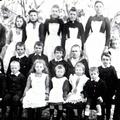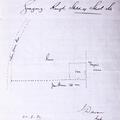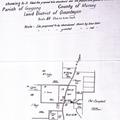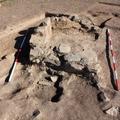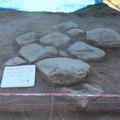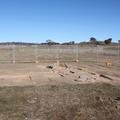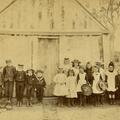< Early Canberra Government Schools
Googong [1883 - 1913]
Googong district and community
Close behind Charles Throsby's explorations in the 1820s, farmers, stockmen and graziers began settling on the best-watered land around the present location of Queanbeyan. One of the first, Timothy Beard, called his run of land 'Quinbean' which is thought to have been an Aboriginal word for 'clear water'. By 1860s the small township of Queanbeyan had gradually grown into a service centre for the district, also catering for passers-by taking the Cooma road to the Monaro and Kiandra goldfields.
The area known as Googong, Googongs or Gugong, just south of Queanbeyan, was a large tract of land taken up in the 1820s as an outstation of Duntroon station owned by Robert Campbell. Alexander McDonald was engaged as the outstation's manager, and a stone cottage was built for him in 1845. McDonald named the cottage 'The Googongs' and continued to occupy it until his death in 1875. The meaning of 'Googong' is not known, however it is thought to be of Aboriginal origin.
Following the Land Act of 1861, free selectors began settling on conditionally purchased land blocks in the locality, just large enough to live on and develop as farms. A selector's life was never easy, especially in their first years of occupation. Under the Act, 25% of the total land cost was paid on application, and the balance paid off in 3 years without interest, or extended indefinitely at 5% interest per annum. Residency was a requirement, so the selector had to erect a dwelling and also improve the property by ₤1 per acre within three years.
To achieve this, the typical selector had to fence his land, maintain a small flock of sheep and perhaps some cattle, sow fodder crops, milk a cow or two, keep a kitchen garden, maintain farming equipment, and, in most cases, provide for a growing family. Not uncommonly, due to the Act's conditions not being met, a struggling selector forfeited his land back to the Crown, his selection then being available to another applicant.
It was this generation of free selectors raising families in the 1880s who made the first moves to obtain a public school at Googong.
The first Googong school, 1883
On 3rd April 1882, a group of Googong citizens petitioned the Minister for Public Instruction in Sydney, requesting that he consider opening a school in their locality. The signatories were John Brown, John Swan, John McCourt, William Feagan, George Stevens, WH Thompson and James Gibbs. It was submitted that there was no school within seven miles, that 33 children would likely enrol, and that a school site thought by the residents 'the most central procurable', could be obtained on a government reserve adjacent to Mr James Brown's property. In return for a favourable decision, the petitioners 'pledged to do all in their power to maintain the necessary attendance'.
(For all Dept. of Educ. records quoted: 'Googong School', 5/16068.3, NSW Archives)
A formal application for the establishment of a public school was made on 28th July 1882, signed this time by three leading citizens: JJ Wright JP, storekeeper; John Brown, grazier; and James Brown, farmer. The form indicated that 25 children within 4 miles would attend: Jane Feagan's children – Anne 14, John 12, Emma 9, Millie 4, Charlotte 6 and Margaret Beatty 12; Sarah McCawley's – Beatrice 5 and Sarah 4; Haynes Thompson's – Douglas 13, Agnes 11, Robert 9 and Mary 8; James Gibbs' – Stephen 9, N Gibbs 7 and J H Graham 7; John Swan's – Sarah 5 and Alice 4; Margaret Stevens' – Henry 7 and Grace 4; John Brown's – Alice 9, Eva 7, Willis 5 and Arthur 3; and William Brown's Mildred, who was 8. All were listed Church of England in religion, except the Thompsons, who were Presbyterian.
Regarding a school site, the applicants offered two alternatives. One that 'A suitable site can be obtained...within a quarter of a mile, upon a Government Reserve, of the residence Mr James Brown of Googongs'; and elsewhere on the application: 'the most central and desirable site is situate(d) on property of James Brown Esq'. In other words, the Department could erect a school on its own site; or else the applicants could provide a schoolroom on their own more convenient site, until the Department was willing to build one.
School Inspector Dawson from Queanbeyan visited Googong to report on the matter. The site map he sketched matched the applicants' first alternative: a school block of two acres in the SE corner of the government reserve (C&WR 27), just outside 280 acres owned by James Brown and 40 acres owned by William Feagan. However, he advised against the Department building a school, at least to begin with, given the uncertainty of future school numbers. Hence the report's conclusion essentially supports the applicants' second proposal - that they provide a school on their own land:
I do not recommend the establishment of a public school at Googong ... however, as an average daily attendance of about 16 pupils could be maintained ... the applicants be informed that the Minister will aid a Provisional School at Googong, as soon as they give notice that suitable school buildings and furniture have been provided and properly secured by lease for school purposes'.
An inspection by the Lands Department in December 1883 found the reserve site 'very uneven and not suitable to the purpose', and proposed a different site on the reserve, facing Cooma road from the west (see map below). However, since this also necessitated the cost of building a school, Inspector Dawson's recommendation which had been 'approved and carried out' by 23rd September 1882, was adhered to.
The first teacher appointed was Elizabeth Brook who transferred from Majura provisional school. She arrived during the mid-summer break, ready to open the school in February 1883. As arranged through John Brown, the classroom was a slab-built farm building of some kind, fitted out with desks, forms and other basic requisites. It was leased to the Department for a moderate sum paid quarterly per year.
The school's anniversary picnic, 1884
This account of the school's first anniversary picnic appeared in the Queanbeyan Age on 8 February 1884. As the report mentions, James Brown who had taken a leading role in securing the school, died a few months before the picnic. Hence the reference that his heart would have been 'gladdened' had he lived to experience the day: -
A very enjoyable day was spent by a numerous gathering, on Tuesday, in the precincts of the provisional school at Googongs, and in connection with the school, which has been established only about twelve months, and under the charge of Miss Brook, the teacher, has, during that short time, prospered well, the school roll being about twenty five, and, judging from personal inspection, the progress made by the pupils highly satisfactory.
The teacher, parents and friends of the pupils attending this school, desirous of celebrating its first anniversary in a suitable way, decided upon giving a picnic on the above named day, and to their credit be it recorded, carried out their intention in a most sumptuous and hospitable manner. Not only were their own immediate neighbours invited, but the same hospitality was extended to a goodly number of the citizens of Queanbeyan.
Amongst the latter were ourselves. On reaching the picnic ground (somewhat late considering that the picnic as we then discovered, meant no mere after dinner gathering, but an outing for the day) a very pleasant sight greeted us. It was pleasant to turn off the main road to Cooma, after a drive of five miles in a smothering, continuous cloud of dust, into the clean and cool bush track leading to the pretty homestead and well-kept gardens of the late Mr James Brown; pleasanter still to pursue the track through paddocks not bare of grass nor destitute of water, as most other pasturages are, till, reaching a slight hollow, we came in view of as picturesque a scene as eyes could wish to feast on. Close sheltered by a cluster of wattles was the unpretending schoolhouse; in the foreground, under the shade of forest trees, beautifying a pretty, gently sloping glade, were numerous buggies and other vehicles; turned out horses grazed around, or drank at a creek of limpid water; groups of young folk were amusing themselves at various methods of pastime, while others sauntered here and there, and knots of their superiors sat here and there watching the sports or engaged in friendly converse.
A little way beyond the school-house was erected a roomy tent. Around this matrons and maidens were apparently busy. It was a pretty sight; and many a less worthy one has been transferred to canvas or paper. Turning our horses adrift with the others, and sheltering the buggy as best we could from the rays of the blazing sun, we drew near to the tent. Here crowding tables spread with substantials and delicacies of every procurable kind, were many more guests regaling themselves in a fashion which proved that exertion and travel had not impaired their appetite, whatever else it had done. They were the third set, and others were waiting to take their places. The busy matrons and maidens mentioned before were waiting on the company; and what with tending the boiling kettles and bringing forth new supplies from hampers and boxes which seemed while they tempted to defy the consuming power of a much larger gathering, they had a busy time of it, to which they addressed themselves with a zest bespeaking the pleasure it gave them to be so employed.
After all had been satisfied and the fair waitresses themselves had enjoyed a well earned meal, all betook themselves to amusement. The older men smoked and chatted, the younger ones directed footraces for prizes amongst the children; the still younger ones with swain-like gallantry, propelled the swings which bore the girls as high as the branches of the tall trees to whose limbs they were attached. One young fellow cleverly manipulated a concertina, to whose music several young couples danced, while elderly ladies, reminded of their own girlhood's days, and mothers nursing babies, looked on. And so passed a very pleasant hour or so. Then someone piped all hands to the tent for some necessary formalities.
Mr Gale of Queanbeyan being voted to the chair, said their gathering at the Googongs that day seemed like a fulfilment of the prophecy that the wilderness should blossom like the rose. Some of those present remembered this locality as a literal wilderness, and now there were gathered there some of the sweetest roses and fairest lilies - the product of its soil. Its population had increased to that extent as to justify the government in establishing a school for the education of their children. He dwelt at some length in extolling the exertions of the Government and the liberality of Parliament in the cause of public education. As a member of the district school-board he took an interest in this school; and he was pleased to see proof before him that the parents of the children also took a deep interest in it. The school roll and attendance book proved that; so did their lavish hospitality that day. It was a pleasant sight for any of them to contemplate, but especially so for his dear old friend Mrs James Brown - the grandmother of the majority of the children attending the Googongs school. One else, whom he would not name, would have had his heart gladdened had he lived to see that day.
The young teacher, Miss Brook, must also be much encouraged by such sympathy and support. He congratulated her upon her success, and was satisfied the school would prosper still further under her diligent teaching. He concluded his address by complimenting the ladies upon the success of the picnic, and giving some counsel to the children.
Mr W G O'Neil of Queanbeyan then, at the request of the chairman, followed with a very interesting address, in the course of which he referred to the early history of Googongs, and gave some excellent advice to the teacher, and parents and children.
Three hearty cheers were then given for the ladies who had provided and assisted in the picnic. These included Mesdames James and John Brown, Gibbs, McAuley, Feagan, Swan, Thompson, Morley, and others whose names did not transpire.
The formal proceedings closed with a verse of the National Anthem.
Sports and pastimes were again resumed and as the sun declined the tables were laid for tea; and the town visitors having first partaken of thereof, horses were attached to vehicles, passengers were seated, and the trip homewards made in the cool of the evening, with all the agreeable impression on the mind of a delightful day's outing. We understand that after the visitors had left some prizes were delivered to the school children; and that dancing brought to a close the first school anniversary at Googongs.
Moves to improve the school
After nearly three years service Elizabeth Brooks was replaced by Bridget Jones, who took up the position in November 1885. By this time, average school attendances were becoming sufficient for the school to be raised in status from a provisional school to a public school, which was was formally announced on 1st January 1887.
As a result, parental interest in having a better school slowly gathered weight. By mid 1888 the parents had Reverend Thomas Symonds from Queanbeyan as spokesperson, writing directly to the Minister for Public Instruction, the Hon. J Inglis, as follows: -
Sir, The people whose children are in attendance at "Googongs" school wish the Government to build a new schoolroom & I have been asked to write to you to obtain all necessary instructions & particulars as to the Petition required to be forwarded for the purpose. Kindly furnish me with these.
I am ... (etc), Thomas Symonds ( Incumbent of Christ Church)
When this letter came to District Inspector Willis at Braidwood to report on, he considered the expense of erecting a new building for only six families in the locality wasn't warranted. He acknowledged that the school's accommodation was 'of very poor quality', but noted that the parents had arranged some improvements which he expected would raise the building to an adequate standard, and that Reverend Symonds be informed accordingly.
Notified of this, John Brown wrote to Inspector Willis in August 1888 that he was willing to fully renovate the building, providing the Department paid for it: -
Sir, Re the school, I will undertake to enlarge the place 8 feet and roof it with gal iron with spouting to catch water, enlarge the fence, repair top of chimney, paper the wall and ceil with calico, find two desks and forms, in fact make the place fit to live in - for the sum of 40 pounds.
I consider it nearly as much trouble as building a new place all the material with the exception of slabs would have to be bought for cash. I am... (etc), John Brown
Some haggling over this continued to the end of the year. On the Minister's direction Inspector Willis informed Brown that the Department would not accept such a large cost on a building it did not own, however if he undertook to complete these improvements at his own expense, it would continue to lease his building for 8 pounds per annum. Next, Reverend Symonds reiterated his request that a new school be built, which the Department declined, offering instead to meet some of the cost of the improvements Brown suggested. Then William Feagan wrote to the Inspector Willis, expressing the community's dismay that if no agreement could be reached before the 'hollowdays', nothing would be done to improve the school until after 'crismas'.
The matter was finally settled in December, following a second offer to Brown: if the school improvements were satisfactorily completed at his cost, the Department would raise its lease to ₤10 per annum. Brown accepted and carried out the renovations. Inspector Willis examined the work in March 1889, and the higher rent was paid to Brown from the beginning of that year.
The full-time school, 1887-1896
After 2½ years at Googong, Bridget Jones was succeeded by another young teacher, Rose Reynolds, who served 1½ years, until November 1890. Miss Reynolds sought to sit for her teaching examination in October 1889 but was informed that because she had not long commenced her career, she was too inexperienced to take the exam. The next year she gave notice that she intended to resign, and did so in November, giving no reason for it. Her replacement, Mary Bronger, who transferred from Sydney, served five years at Googong, until October 1895.
Annual school picnics during Miss Bronger's years were fun for all concerned, including the school's staunch supporter, Reverend Symonds. In April 1892, as reported by Goulburn Post: 'The annual picnic of the Googong Public school took place on Saturday. The scholars under Miss Bronger attended in full strength and enjoyed themselves immensely. There were the usual games and amusements, races and other sports, to the delight of all present'.
In March the next year, the Post reported:'The Googong School picnic took place at what is called the 5 mile reserve. There was a large attendance of friends and relatives, amongst whom were a number of ladies and gentlemen from town. Mesdames Feagan, Brown and McCawley aided by their daughters, the schoolteacher (Miss Bronger) and others provided and dispensed the refreshments. Several quiet picnic games were indulged in, and a few races for the children were conducted by Rev. T Symonds and Messrs McDonald, Garraway, Beatty and Hayes'.
A developing problem however, was that pupil numbers were declining. In June 1893 John Brown was asked to give evidence that pupil numbers justified the school remaining full-time, rather than reduced to operating half-time - sharing one teacher with a similar-sized school. When he informed Inspector Cooper that only 16 children would be attending, the case to remain full-time was marginal; however the inspector recommended that it remain full-time for the present, which the Department accepted.
As listed by John Brown, 16 children from four families were attending the school at this time: William Feagan's children - Sydney 12, Alexander 10 and Evelyn 7; Margaret Swan's - Fanny 12, William 11, John 9, Arthur 7 and George 5; John McCawley's - Sarah 13, Thomas 11, Courtney 9 and Robert 7; and John Brown's – Arthur 13, Ella 11, Edith 8 and James 6. All were Church of England in religion.
By 1895 pupil numbers were again a problem. When the average attendance declined to 11.9 - just below a minimum full-time quota of 12, Inspector Cooper appealed for the school 'be given another trial' to raise enrolments, but was over-ruled. In October 1895, Mary Bronger was transferred, and the school temporarily closed pending its re-opening as a half-time school. When Cooper was invited to explain why the school should not be fully closed, given there was no similar-sized school within reasonable distance, he responded vigorously in the school's defense: 'Having regard to the interests of the children concerned, and to the spirit of the Public Instruction Act, the closing of this school would, I submit, not be justified'. Instead, he suggested, the Department could appoint an ex-pupil teacher to Googong, thereby keeping it open at less cost to the government.
Chief Inspector McIntyre at Sydney thought otherwise, firmly instructing him to recommend closing the school. Cooper, however, stood firm, wording a response clearly intended to receive the Minister's measured attention: -
I would urge for the Minister's consideration the advisedness of giving the school another trial. Apart from other essential points, the fact that a building and furniture are provided without cost to the Department, and that twice the Ministerial promise as to the continuance of the school, made in June 1893, for which worthy efforts to maintain a regular attendance have been made, should not be lost sight of.
Cooper's stout defense prevailed: when the memo finally came before the Minister, he scrawled a brief determination - 'The school may have another chance'.
Googong was two months without a teacher while the school's future was debated. Then in January 1896, Kate McDonald, a lower salaried ex-pupil teacher from Goulburn, succeeded Mary Bronger. By this time however, there were only 12 school-aged children in the district, and inevitably the average attendance dipped under quota. Then in July 1896 Miss McDonald cabled a desperate telegram to Inspector Cooper: 'Brown demands key school and refuses to allow me to enter it'. The cause of this kerfuffle was that no rent had been paid to John Brown during the school's two-month closure. Called upon to explain his action, Brown informed the Department that he had sought to collect the keys because 'the dept will not guarantee anything' about paying for the lease.
But as Brown soon found out, the Department declined to be stood over. Two weeks later Kate McDonald was promptly transferred to Bethungra provisional school, and for the next six months Googong's school stood empty – no classes conducted and no rent paid to John Brown.
The half-time school, 1897-1913
After this six months closure, Googong remained a half-time school for the rest of its years, closing permanently in 1913. Also, as the Department considered weekly horse riding between half-time schools unsuited to female teachers, all of the school's appointees from 1897 to 1913 were men.
To the community's relief no doubt, Inspector Cooper recommended that the school be re-opened in January 1897: an enrolment of 14 children had been assured, the former building was still suitable in his view, and a nominal lease offered to the Department by Mr Brown, 'for one year with a promise of renewal at a peppercorn rental' (Brown, it appears, forgoing higher rent to help re-open the school).
An application 'For Establishment of a Half-Time School' - submitted the year before, stated that the following pupils would attend: Margaret Swan's children - John 12, Arthur 10, George 8 and James 6; Sarah McCawley's - Courtney 15; Robert 11, Grace 8 and Willie 6; John Brown's - Edith 12, James 10 and Alice 7; Mrs Feagan's - Alexander 12, Evelyn 11 and Ada 8.
On the Department's approval the school re-opened. William Rolfe was appointed, and for the next 3½ years taught at both Googong and Stony Creek (3 miles east of Queanbeyan), visiting each school half-weekly on horseback. Rolfe was a capable teacher who served the school well. For the first time, for example, there are reports of Googong participating in combined-schools athletics carnivals at Goulburn. And at the 1898 carnival, the school would have been proud to see its own pupil, George Swan, come equal first in the boys' under-14 high jump. He excelled even better the next year, by winning the event.
When it was announced in 1900 that their popular teacher would soon be leaving, the community gave Rolfe a fond farewell - dancing well into the night at the home of the school's champion high jumper. Queanbeyan Age described the function as follows: -
At Googongs on Saturday, Mr W Rolfe, teacher at Stonycreek and Googongs half-time schools, was presented with a pair of gold sleeve links, accompanied by an address from the children, and a further present of a Gladstone bag from the cricketers and friends at Googongs. The links were presented by the hand of Miss Ada Feagan, and the address was read by Master Robert McCawley. Mr S Gibbs made the presentation of the bag.
Mr Rolfe, in returning thanks, thanked the pupils from the bottom of his heart. He would keep and cherish their token of respect all his life. It had always been his desire to do his duty and their action that day showed that his efforts had been appreciated. He hoped that after he left them, as soon he would do, owing to the small attendances at the school, that they would continue to be the same loving, respectful, attentive and well conducted pupils. To the cricketers and his many friends at Googongs he also returned hearty thanks...He had met with nothing but kindness from Googongs during his three years residence with them. Whenever opportunity offered he would return to spend a few days with them, for he could honestly say he had made some of the dearest friends of his life in Queanbeyan and Googongs.
Three cheers were then given for Mr Rolfe, and games resumed. In the evening a dance was held at Mrs J Swann's. (Trove: Queanbeyan Age, 11 April 1900)
As it happened, the school stayed open a few months longer than expected. In September 1900, when Rolfe received news that his mother in Sydney had died, he was allowed a week's leave to travel home. He continued teaching at Googong until the school closed on 29th July 1901, then was transferred to Duntroon and Malcolm Vale half-time schools.
Rolfe's last memo from Googong to Inspector Cooper, concerned whether or not the school material and furniture should be sent to his new schools. After nearly 20 years, there was understandable uncertainty about their ownership - as Rolfe conveyed to the inspector: -
I am in a difficulty over the material in Googong school. Mrs Feagan contends that the forms belong to the people of Googong and should not be shifted to Duntroon. The other parents seem to be uncertain as to whom the forms and desks belong, this being the case I thought it would be better for me to leave the desks and forms there until I heard from you.
After much scrutiny of the Department's old records, the matter was eventually resolved. Documented back to 1882, it was found that John Brown and the community had been required to furnish the school as a condition of the Department leasing it for ten pounds a year.
Three years after the school closed, the Lands Department was asked to survey the same school site in the Reserve it had trace-mapped in 1883. Its subsequent report - of 20th January 1905, stated: 'as the land is not held under lease or license, there is no objection to your Department entering into occupation of the land'. On the same memo, a Department of Public Instruction recipient added the comment: 'Building ready for occupation 16/6/05'. Parish maps identify this 2-acre school site as Portion 51 on Reserve C&WR 2 - notified for school purposes on 9th September 1905. Hence it appears that Googong school was rebuilt on this site in 1905, though further evidence of this awaits discovery.
Clement McAllister was Googong's teacher for most of 1905, travelling each week to his other half-time school at Black Creek, Molonglo. Then in November 1905, when Black Creek was raised to full-time, Googong was made half-time with Burra. This resulted in Alexander Jennings replacing McAllister, as Jennings was the half-time teacher at Burra. After six months at Googong, Jennings was transferred to Reidsdale, in the Braidwood district. His replacement was James Bowe, from Goulburn superior school, who continued the half-weekly teaching at Googong and Burra.
After this constant turnover, the Googong community would have been relieved that James Bowe served six years at the school. He appears to have been a well-respected member of the community, and when he departed in May 1912 the Queanbeyan Age reported 'the local rifle club loses one of its best shots'. The last two teachers at Googong continued teaching half-weekly at Burra: Charles McGrath, who served from August 1912 to February 1913; then after a short school closure, Richard Finnegan served from May to October 1913. Although the details are missing, there is no doubt that the Googong closed in 1913 due to insufficient pupils .
In January 1916 a Queanbeyan man, Charles Boyd, wrote to the Department asking what value it placed on the school buildings as they had 'not been used for over 2 years and there are practically no families in the district'. His approach didn't progress. Three years later, however, the Department accepted Mr Goiser's tender of 16 pounds 10 shillings to remove the school.
(Contributed by Keith Amos, former teacher at The Mullion, out of Yass)
The story of the discovery and excavation of the Googong school site was presented by ABC News.
An article was also printed in the Canberra Times :
ANU Archaeologists unearth 19th century history at Googong
Georgina Connery and Alice Rennison
Pieces of rusted door hinges, roofing nails, stone walls and slate pencils are artefacts providing clues about a forgotten school in Googong.
Archaeologists have unearthed a 19th-century schoolhouse on land set to be developed as the newly constructed township expands.
In a search for lost local history, archaeologists, university students and even primary schoolers are working together at a dig site in Googong.
Navin Officer Heritage Consultants excavation director Dr Rebecca Parkes said there were very few historical records about the site and the project was an example of how archaeology could fill in the blanks.
"One of the beauties of archaeology is that it can tell the story that history doesn't, and about all the people that history forgets, the everyday people," she said.
"We have a stone fireplace and flagging stones where we think the door was. We don't have much more so the lack of evidence suggests it was a timber building."
Teams had little more than the name of the historical landowner, James Brown, and a few newspaper clipping before digging began.
The project is part of the environmental and heritage survey works being undertaken by Googong township developers Peet Limited and Mirvac.Along with studying features of the area's pastoral history the dig includes several sites of indigenous significance.
Australian National University (ANU) first year archaeology student Angus Harden undertook his first fieldwork as part of the five-week excavation, putting his tertiary studies into practice.
However, more than 100 primary school students from three different schools have learned about the fundamentals of archaeology during on site excursions. Dr Parkes said artefacts would be removed for preservation after the are was mapped in detail.
And there's a plan to create an activity pack in partnership with The Anglican School Googong and Queanbeyan Museum, so the once lost local history can be used as an education resource into the future.
"We want to make sure the legacy of the heritage is carried on in the suburb," she said.
"We can put together a package of things you can do with the artefacts and that will be made accessible to other schools in the area."
Once the trowels, brushes and shovels are put away the public is invited to take a look at the site during an open day to be held on June 24.
[Canberra Times 5th June 2017]
Location Map
Related Photos
Teachers
- Brook, Elizabeth
01/1883 - 10/1885 - Jones, Bridget
11/1885 - 07/1888 - Reynolds, Rose A
07/1888 - 11/1890 - Bronger, Mary Ann
11/1890 - 10/1895 - McDonald, Kate
01/1896 - 07/1896 - Rolfe, William Joseph
01/1897 - 07/1901 - McAlister, Clement M.A.
01/1905 - 11/1905 - Jennings, Alexander
11/1905 - 06/1906 - Bowe, Mr James
06/1906 - 05/1912 - McGrath, Mr Charles
08/1912 - 02/1913 - Finnegan, Mr Richard
05/1913 - 10/1913
NSW Government schools from 1848
- Googong (external link)
< Early Canberra Government Schools
If you are able to assist our work of identifying, documenting, and celebrating the early bush schools of the Canberra region, please contact us or .


